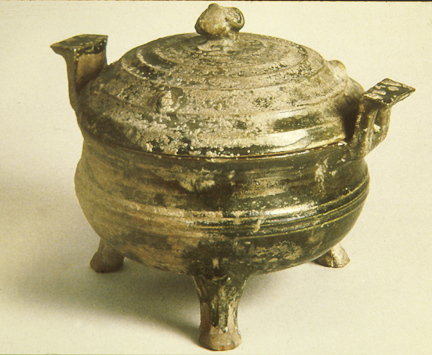
HAN DYNASTY LEAD GLAZED TRIPOD JAR (DING),
China, Honan Province, 206 BCE - 220 CE
ART 198 - HISTORY OF WORLD CERAMICS
| This is a tripod covered jar of DING form from the Han Dynasty (206 BCE - 220 CE). The dark green glaze is very high in lead and vessels glazed with this poisonous glaze were exclusively used as burial ware. Lead carbonate was also used by the Chinese to create a white facial powder, so clearly they were not completely aware of its toxic nature. The appearance of lead glazing in China is roughly coincidental with its use in Rome, although no direct connection between these events has been shown. Only three glaze colors were known to the Han potters: green, made with copper oxide; transparent (which appeared amber over a brown clay); and a darker brown made by adding iron oxide to the transparent glaze. The shapes of Han ceramic vessels took inspiration from bronze vessels, as in this piece which recalls the Ding shape. The encrustations seen on the surface of the glaze are caused by weathering from being buried in wet or corrosive conditions. | HAN DYNASTY LEAD GLAZED TRIPOD JAR (DING), China, Honan Province, 206 BCE - 220 CE |
|
|